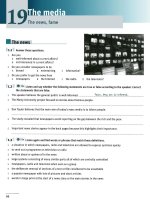ielts vocabulary IELTS TARGET
Bạn đang xem bản rút gọn của tài liệu. Xem và tải ngay bản đầy đủ của tài liệu tại đây (35.34 KB, 4 trang )
Task 1:
The table illustrates the information about the proportion of literacy from Africa, Americas, Asia, Europe
and Oceania by sexual gender in 4 years (k cần thiết lắm do phía sau đã có from..to..) from 2000 to 2004.
Overall, it is clear that in total the number of males, comparatively, was higher than female in all around
the world. It is also noticeable that in Americas, Europe and Oceania the amount of the literacy rates
were the dominant regions, accounting for over 90 percent of the population able to read and write.
(Overall, men took up a higher portion of the literacy rate than women. Meanwhile, most of the literate
population are distributed in America, Europe and Oceania)
Looking at the table more closely, one can see that Europes had the highest rates, made up of
approximately 99 percent. The proportion between the two genders in Europes was nearly equal. During
the same period, in Oceania and the Americas, the figures for both sexes were relatively evenly
distributed, which accounted for over 95%.
(Among the regions, Europe had the highest rate, made up of approximately 99 percent. During the
same period, both Oceania and America shared the same figure of over 93%. There was no visibly
difference in literacy rates between the two genders in these continents, with the variation being
relatively smaller than 1%)
In Asia and Africa, the gap in literacy rates among between the two genders had widened. In Asia, only
72.5% of women were able to read and write, whereas the figure of men was 13% higher. The number of
literate population hit a low of 62.5% in Africa, with 53.9% and 71.6% of all African women and men
being literated respectively.
(In Asia and Africa, the gap in literacy rates between females and males was considerably noticeable. In
Asia, only 72.5% of women were able to read and write, whereas the figure for men was 13% higher. In
the meantime, the percentages of literate population in Africa was the lowest, being only 62.5%. There
was a 17.7% difference between the number of literate men and women, with 71.6% and 53.9%,
respectively.)
Task 2:
It is a common belief that rather than merely paying attention to the benefits of globalization, individuals
should be concerned about its negative aspects as well. However, I firmly believe that in the long term,
the economic advantages will overshadow the modest drawbacks.
To begin with, globalization will lead to the lack of local businesses. Local firms are at a disadvangtage as
a result of globalization policies that favor corporations who have the resources and infrastructure to
operate their supply chains or distribution in many different nations. (Câu này bị dài qué, có thể sửa
thành: This is due to the fact that globalization policies are in favor of corporations with resources and
supply chains distributed in different nations.)For instances, a local Viet Nam logistics joint may struggle
to compete with the prices of a multinational corporation such as DHL global forwarding. Nevertheless,
competition played a key role in form’s motivation. By increasing the international exchange of goods,
technological advances and information, globalization increases economic development for any country
participating in the global economy. It can not be denied that an increase in economic growth means
better living standards, higher incomes, more wealth in a country, and often, less poverty – in short, the
overall well-being of a country. (Đoạn từ By increasing….tới hết hong phù hợp để bỏ vào đoạn này. Đoạn
này mở đầu đang là cấu trúc là disadvantage of globalization, nếu để chung bị loạn ý chung cả bài. Nếu
chia dạng thì phải là 1 đoạn disadvantage và 1 đoạn advantage. Nếu khơng thì chia 2 đoạn, mỗi đoạn nói
về 1 advantage + 1 disadvantage liên quan đến nhau.)
On top of that, a global market allows businesses wider access to production opportunities and
consumers, meaning that there are more goods available at a wider range of price points. This
undoubtedly influences and encourages other internal firms to work hard and produce quality products.
In the FMCG field, for example, the adhesion of top companyies such as P&G and Unilever bring a lot of
options in various prices for consumers also promote economic growth. In addition, globalization brings
opportunities to poorer countries. It allows companies to move their production from high-cost locations
to lower-cost locations abroad, which means jobs, information technology and other economic
possibilities must be brought to nations with limited resources. For example, in the last several decades,
many Asian countries such as Vietnam and China are the ideal destination for businesses which that
decide to reduce labor costs and take advantage of the favorable geographical location.
(Với 2 ý chính lớn như vậy thì có thể chỉ đưa example cho 1 ý thôi, thường là ý sau. Phần này khá ổn, có
hơi dài tí nhưng mà có thể cắt gọn lại được. VD: In addition, globalization stimulates economic
opportunities in developing countries. Companies are encourages to distribute their productions in
lower-cost locations and thus, creates economic and technology potentials to other nations with limited
resources. For example, many Asian countries like Vietnam and China are ideal destionations with an
abundant sources of labor and geographical assets.)
To sum up, the cultural and economic advantages of globalization are justified. For these reasons, it is
clear that each nation should intergrate the international market and create more opportunities for
people to approach the advanced life. (Đoạn này nên nhấn mạnh lại cái choice của mình. VD: To sum up,
it is undeniable that globalization brings both positive and negative aspects to the economy.
Nonetheless, I strongly believe that being integrated in the international market will provoke beneficial
opportunities for each nation. The unfavorable sides of globalization can be coped with and reduce if
there is a careful management and balance from the authorities and companies.)
Task 1:
The bar graph shows more than 5 portions of vegetables and fish per day are were consumed in the
United Kingdom from 2011 to 2017.
(The bar graph shows the number of people consuming more than 5 servings of vegetables and fish per
day between 2011 and 2017.)
Overall, it is clear that women had the highest numbers for all the time. Besides, the proportion of
children and man increased slightly over the period.
(Overall, the percentages of women, men and children grew throughout the period, with women had the
highest rise. Meanwhile, children only experienced a modest increase compared to others)
Looking at the graph more closely, one can see that in the first 3 years, the number of women accounted
for 20% also remain stable, which make the the individual with highest rate of consumption for the
period. The proportion of women began surge dramatically from 2004 and peaked at 36% in 2016 before
a fall to 30% to end the period. As was the case with males and kids, the rate of males grew steadily over
the whole 7 years and reach the highest point of 26% in the end. The proportion of children fluctuated
over the 7 years period and the increase for children, comparatively, was modest.
(It can be seen that in the first 3 years, women remained a stable number of 20%, making the individual
having the highest rate of consumption. The proportion of women began to surge dramatically from
2004 and reached a peak in 2016 (36%) before a fall in 2017 (30%). In the meantime, men witnessed a
steady growth over the period of 6 years and finally attained a highest point of 26% in the end.
The figure of children was lowest to begin with (10%). Though it had a slight upturn in the following year,
the number fluctuated and finished at 15% in 2017)
Task 1:
The pie charts illustrate the proportion of the five types of energy production of France in 1995 and
2005.
Overall, it is clear that the most significant sources of energy were gas, coal and petro, which accounted
for the highest rate in both 2 years, while nuclear and other kinds of energy sources generated the least
amount of energy in France. Aslo evident is that there were some slight shifts over the 10 year period.
(Phần overall ngắn gọn, không cần đưa số liệu hay thời gian vào quá chi tiết)
(Overall, the most common sources of energy were gas, coal and petro. All form of enery had a modest
growth, whereas only petro decreased over the time.)
Looking ar the pie charts more closely, one can see that the proportion of gas and coal, which together
accounted for more than half of the total in 1995, went up slightly to nearly 1% in 2005. In contrast, the
share of petro production plummeted remarkably of 10% to 19,5% during the 10 years period. Even
though the proportion of petro decreased, it still more than nuclear and other combined. On the other
hand, there was approximate 5% growth in production from both nuclear power and other sources to
10.1% and 9.1% respectively.
(In 1995, gas and coal made up of more than half of the total sources of energy in France, with 29.63%
and 29.8%, respectively. After 10 years, they both experienced a slight increase of approximately 1% in
2005. In contrast, the share of petro production plummeted remarkably to 19.5% during the 10-year
period.
On the other hand, there was a rise of approximately 5% in production of both nuclear power (10.1%)
and other sources (9.15) compared to the year 1995.)
Task 2:
It is a common belief that it is necessary to prohibit touristry in some places in order to preserve local
culture. However, there is a more persuasive argument that change is unavoidable, and prohibiting
tourists will have little effect on…something... (thiếu câu đưa ra opinion)
On the one hand (nếu xài cụm này thì đoạn sau phải bắt đầu bằng On the other hand), it is essential to
ban tourism in some sacred places. (Câu mở đầu tiên nên là main idea để câu sau mở rộng ra, VD: On
the one hand, banning tourism in sacred places is essential to respect the spiritual cultures). Indigenous
people typically respect spiritual locations because these are where they spiritually connect with the
gods. Nonetheless, many travelers are unaware of this and are preoccupied with things like snapping
pictures or conversing with people, which generate a lot of noise.(Câu này hơi informal: Nonetheless,
some travelers are unware of this and may have actions which are considered disrespectful to the local
cultures) As a result, the inhabitants are exceedingly uncomfortable and their spiritual conversation with
their creators is disrupted. (As a result, the inhabitants might be uncomfortable and that their spiritual
activites are being insulted). For example, in many temples and pagodas in Vietnam do not allow
photographs and urge vistitors to be silent and dress modestly. These are the mandatory provisions for
preserving the sanctity of those holy places.
Nevertheless, I support the idea that preventing tourists from visting some special locations is
unnecessary (Câu đầu tiên nên là main idea). Due to everything evolves through time, it is an inevitable
rules of nature. (Câu này hơi hướng văn chương nhiều, sợ hong hợp với ielts)There are many places
which were critical in the past and these are our memory- keepers of histories. Such places will aid in the
transmission of culture as well as cementing of people through generations. Independence palace of
Vietnam today, for instance, is entirely for tourism instead of the president’s residence as it was in the
past. The result is that the history of Vietnam is spread to friends around the globe. (Đoạn này khoan
đưa ý kiến mình vào. Đề yêu cầu discuss both views thì cả 2 đoạn thân bài đứng ở vị trí trung lập. Chỉ có
mở bài và kết bài mới nhấn mạnh ý kiến của mình. M xem sửa lại đoạn này nha)
To sum up, while it is apparent that banning travelers in some areas help to maintain local cuture, it is
undeniable that converting those places into tourist attractions is more beneficial. (Thêm 1 câu đưa ra
solution giải quyết cái vấn đề. VD: Therefore, it falls onto the local authorities to have detailed policies
for managing tourism in these areas and preserving the local cultures)









